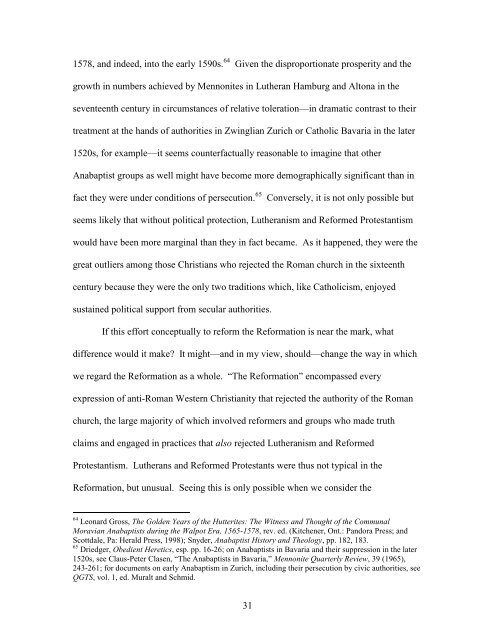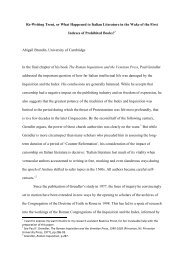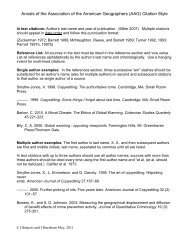Brad S. Gregory - Augustana College
Brad S. Gregory - Augustana College
Brad S. Gregory - Augustana College
Create successful ePaper yourself
Turn your PDF publications into a flip-book with our unique Google optimized e-Paper software.
1578, and indeed, into the early 1590s. 64 Given the disproportionate prosperity and the<br />
growth in numbers achieved by Mennonites in Lutheran Hamburg and Altona in the<br />
seventeenth century in circumstances of relative toleration—in dramatic contrast to their<br />
treatment at the hands of authorities in Zwinglian Zurich or Catholic Bavaria in the later<br />
1520s, for example—it seems counterfactually reasonable to imagine that other<br />
Anabaptist groups as well might have become more demographically significant than in<br />
fact they were under conditions of persecution. 65 Conversely, it is not only possible but<br />
seems likely that without political protection, Lutheranism and Reformed Protestantism<br />
would have been more marginal than they in fact became. As it happened, they were the<br />
great outliers among those Christians who rejected the Roman church in the sixteenth<br />
century because they were the only two traditions which, like Catholicism, enjoyed<br />
sustained political support from secular authorities.<br />
If this effort conceptually to reform the Reformation is near the mark, what<br />
difference would it make? It might—and in my view, should—change the way in which<br />
we regard the Reformation as a whole. “The Reformation” encompassed every<br />
expression of anti-Roman Western Christianity that rejected the authority of the Roman<br />
church, the large majority of which involved reformers and groups who made truth<br />
claims and engaged in practices that also rejected Lutheranism and Reformed<br />
Protestantism. Lutherans and Reformed Protestants were thus not typical in the<br />
Reformation, but unusual. Seeing this is only possible when we consider the<br />
64 Leonard Gross, The Golden Years of the Hutterites: The Witness and Thought of the Communal<br />
Moravian Anabaptists during the Walpot Era, 1565-1578, rev. ed. (Kitchener, Ont.: Pandora Press; and<br />
Scottdale, Pa: Herald Press, 1998); Snyder, Anabaptist History and Theology, pp. 182, 183.<br />
65 Driedger, Obedient Heretics, esp. pp. 16-26; on Anabaptists in Bavaria and their suppression in the later<br />
1520s, see Claus-Peter Clasen, “The Anabaptists in Bavaria,” Mennonite Quarterly Review, 39 (1965),<br />
243-261; for documents on early Anabaptism in Zurich, including their persecution by civic authorities, see<br />
QGTS, vol. 1, ed. Muralt and Schmid.<br />
31
















